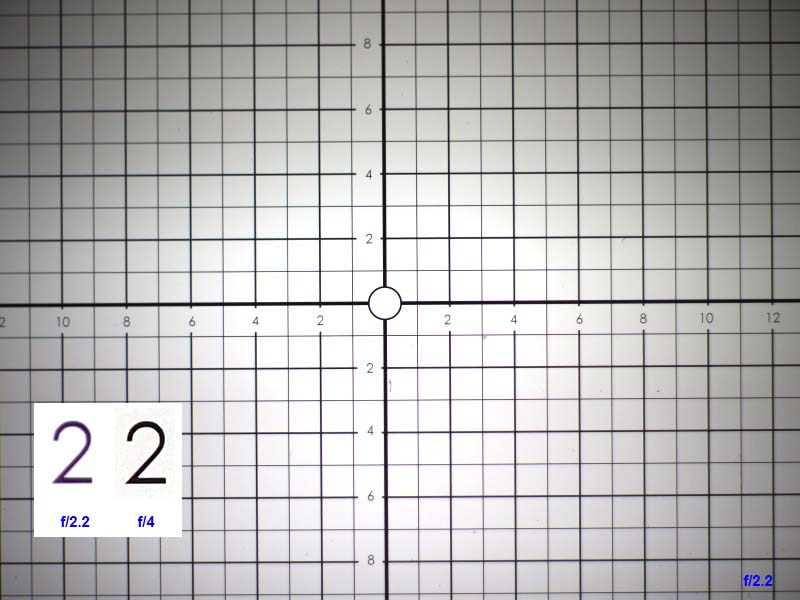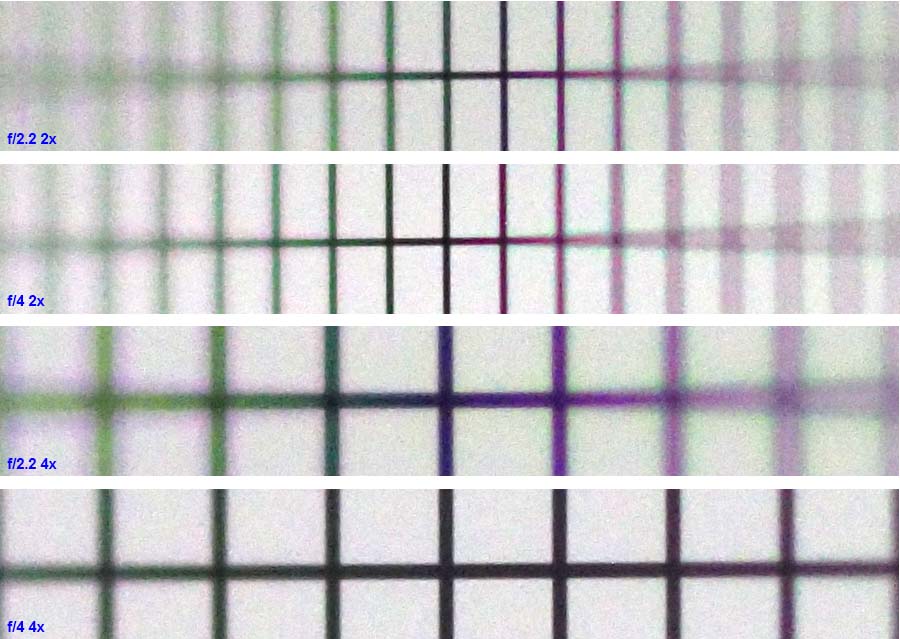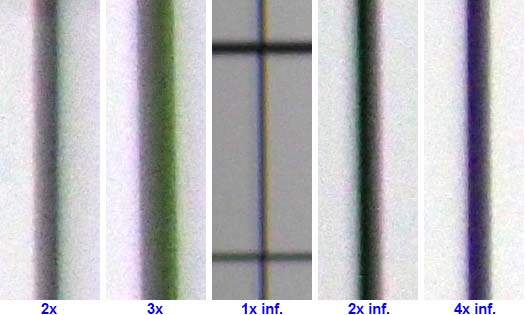Schneider Xenon-E 50 mm f/2.2The Schneider Xenon-E 50 mm f/2.2 is a machine-vision lens in metal barrel. Xenon is one of the classical lens formulas, characterized (together with many others, including the double-Gauss as probably the earliest example) by the use of two outermost single elements at either end and two innermost doublets. E stands for Emerald, a recently introduced Schneider name for a series of lenses. The Xenon-E 50 mm is the cheapest and fastest of the Emerald lenses, and it is difficult to understand what it shares with the other Emerald lenses. The latter appear to be more specialized for machine vision, e.g., a few of them come in two versions, one optimized for short and one for long focusing distances - but not the 50 mm. The placement of this lens in the Emerald series could be an afterthought of the Schneider marketing division. In fact, early specimens of this lens, like the one in the above figure, were produced without the E branding, but are otherwise identical to later ones. It is also open to question how this lens differs from the many other 50 mm f/2.2 Xenons produced by Schneider over the span of several decades. The Xenon optical formula is unsophisticated by today's standards, but many legacy lenses for photomacrography, including Nikon Macro Nikkors, Zeiss Luminars and Leitz Photars, use similar or even simpler formulas. On the other hand, sophisticated legacy lenses like the Nikon Printing Nikkors and many modern macro lenses contain almost three times the number of elements of a typical Xenon. Most of the legacy Xenon lenses are general-purpose "normal" lenses designed for a limited range of focusing distances that includes infinity. In the rest of this discussion, I refer to this lens as Xenon-E 50 mm. According to the specifications, this lens is optimized for a magnification of 0.2x to infinity focus. Distortion is minimal at 0.1x. The FL (Focal Length) is 51.2 mm and the aperture ranges from f/2.2 to slightly beyond f/11, without click-stops. This lens is remarkably expensive for its simple optical formula (US$958.95 on B&H at the time of writing). One aspect of the present tests is to verify whether the lens is worth the asking price, compared to other current and legacy lenses. This is not a common lens, and except for a small second-hand stock offered on eBay USA in 2016, it is rarely available on the second-handmarket. Plenty of old Schneider Xenon 50 mm f/2.2 models, on the other hand, are available in a variety of mounts and at rather low prices. These lenses do not seem to have a large group of fans among users of legacy lenses. Lens mechanicsThe aperture scale is repeated three times around the circumference of the aperture ring and a locking thumbscrew can be used in any of three threaded sockets spaced around the ring. The front filter thread is M43. Although this lens is specified to come in alternative mounts (Nikon F, Canon, and V48, which is a Schneider proprietary V-groove mount used for macro, line-scan and machine-vision lenses), in reality the lens barrel only has a 25 mm long M40 thread, and the lens is accompanied by a lockable adapter with one of the mentioned attachments. The long M40 thread is used as a focusing helicoid, not intended for continuous adjustments but only to be locked in a set position once focus is attained. The whole lens barrel rotates within the adapter when focusing. This reflects the planned use of the lens, permanently mounted on a fixed videocamera and trained and focused onto a specific point of an assembly line. In total, the barrel is about 50 mm long, which is on the high side for a 50 mm lens. Front and rear elements are close to the respective ends of the barrel, but do not project from the latter. There is no scarcity of 50 mm generic camera lenses on the market, and therefore I was mostly interested in this lens for using it at 1x or higher, not in general photography at 0.2x or less. A thread in photomacrography.net showed initial tests at magnifications from 1x to 4x (with the lens reversed), but opinions on this lens were not high. Among those findings, the lens suffers from mediocre resolution, chromatic aberration of both types, and a focus shift that takes place when stopping down from f/2.2 to other apertures. Posters suggest stopping down to f/5.6 or f/8 to improve the lens performance. Focusing should be done after stopping down to at least f/4. In short, the f/2.2 aperture is unusable in practice. Mounting the lensAn M43 reversing ring is the easiest way to mount this lens in reversed orientation. The above figure shows a reversing ring ending in an M42 x 1 thread. For this test, I mounted the reversed lens onto an Olympus OM Telescopic Auto Tube 65–116 with adapters at either end. This provides a magnification range between 2.08x and 3.09x. An M42 to M40 step-down adapter ring can be attached on the reversed lens as a short lens shade. It is not practical to use a longer lens shade because of the already short working distance and relatively high diameter of the M40 thread. The lens in theoryThe rear end of the barrel is only 28.4 mm from the focal plane at infinity, so this lens cannot be used to shoot at infinity on a DSLR. The built-in M40 thread can be used to focus at infinity with the supplied Nikon or Canon adapter, and the lens can be focused at infinity on a mirrorless camera equipped with a suitable lens adapter. The short sensor-to-lens distance also means that, once reversed, this lens has an unusually short working distance for a 50 mm lens. Using a reversed 50 mm SLR/DSLR lens would provide a longer working distance at a given magnification. The specified image circle is 43.2 mm (presumably, at infinity). This is exactly enough to cover a full frame sensor. Lens test

Bottom: 1:1 pixel crops at different apertures. 
Bottom: 1:1 pixel crops at different apertures. For resolution and contrast testing, I used a chrome-on-glass alignments target designed for semiconductor manufacturing. The grid on this target is somwhat finer than 1 mm. I further used a microscope calibration ruler slightly oblique to the focal plane to test for axial chromatic aberration. I tested at 2.08x and 3.09x only (in practice, 2x and 3x), on the Olympus OM Telescopic Auto Tube with adapters (see above), and at intervals of one tick on the aperture scale (i.e. one-stop intervals except for the step from f/2.2 to f/2.8). I used a 20 Mpixel Olympus E-M1 Mark II for this test, with electronic shutter and automatic exposure. I manually adjusted the brightness of the LED transmission illuminator to avoid exposure times shorter than 1/250s (which gives horizontal banding with electronic shutter on my camera) or longer than 1/60s (which seems to cause a shift to a colder color balance, for reasons unknown). These problems are specific of electronic shutter on this camera. This lens behaves in an odd way at f/2.2 and f/2.8. At these apertures, axial chromatic aberration is extremely strong, and in addition it behaves differently at different wavelengths. Like in the large majority of lenses, because of axial chromatic aberration this lenses focuses green light and magenta light on different focal planes. However, green rays are focused to form a sharp image, while magenta rays form a much blurrier image. When stopping down to f/4, the plane where green light is focused is sharp enough to provide a sharp image also in other colors. I believe this is the phenomenon that others have described as focus shift in this lens. At 2x, diffraction blurring is visible in 1:1 pixel crops from f/5.6. At 3x, it is already visible at f/4. At both magnifications, f/4 is the fastest aperture that provides a good control of axial chromatic aberration. Therefore, for best image quality, at 2x this lens should be stopped down to between f/4 and f/5.6. At 3x, this lens can only be used at f/4, which is already moderately affected by diffraction blurring. It cannot be stopped down without further blurring, or opened up because of axial chromatic aberration. 
Axial chromatic aberration is best tested with an inclined resolution target. This test shows that the blurring is asymmetrical about the plane of focus, with the "magenta side" (closer to the lens) displaying also a strong spherical aberration while the "green side" remains sharper. The asymmetrical blur may be a result of a design optimization to render an out-of-focus background with a more pleasant bokeh. This is an optimization commonly done for lenses for generic photography, especially legacy ones. This also suggests that the present lens is largely a rehash of an old design, rather than a lens specifically designed for machine vision. Stopping down to f/4 substantially improves the sharpness in the plane of focus, and reduces but does not completely eliminate either aberration outside the narrow zone of focus. This confirms the observations done during the preceding test. Transversal chromatic aberration is practically absent after stopping down to f/4-f/5.6. Schneider Xenon-E 50 mm as infinity-conjugate lensGiven that this lens is specified as usable when focused at infinity in its normal orientation, it is theoretically feasible to reverse it and mount it on an infinity-corrected system equpped with a tube lens. In an infinity-corrected system, magnification is changed by changing the FL of the tube lens. For this test, I used three Olympus OM legacy SLR lenses, mounted on Micro 4/3 via adapters, as tube lenses. The tube lenses were used fully open and focused at infinity. In general terms, the total magnification (M) of an infinity-corrected system is given by 
where fT is the FL of the tube lens, and fL the FL of the front lens/objective. One consequence of changing the magnification by choosing a different tube lens FL is that the working distance of the objective (and therefore its NA) remain constant at different magnifications. The tube lenses and the expected magnification (assuming a 50 mm FL for the Xenon-E and the nominal FL of the tube lenses) are listed below.
One of my reasons for choosing these lenses is that Olympus OM lenses are generally recognized as good quality, but are available at far lower prices than equivalent Nikon and Canon lenses. Another reason is that Olympus OM lenses (and these models in particular) are mechanically well-built (all-metal barrels) but compact because of their limited speed. Staying away from very fast lenses also means that these relatively slow lenses were designed with fewer compromises on image quality. Lens speed is rarely a factor when choosing a tube lens, since at magnifications above 1x the effective aperture is in most cases limited by the objective. A third reason is that all chosen lenses use 49 mm filters, simplifying the choice of adapters. The main usefulness of infinity-corrected systems is the possibility of inserting additional optics between objective and tube lens without re-adjusting their reciprocal distance or changing the total magnification of the system. For this purpose, infinity systems usually have a significant spacing between lens and tube lens. Tube lenses of 200 mm FL are often used in commercial systems, because a tube lens of long FL minimizes the aberrations introduced by off-axis rays. When using camera lenses as tube lenses, a minimal distance between objective and tube lens usually works best, and the FL of the tube lens can be as short as feasible to avoid vignetting and off-axis aberrations. The Xenon-E 50 mm was mounted as close as possible to the front of the tube lens via M43-M42 reversing ring and step-up M42-M49 ring. As a general formula, the NA (Numerical Aperture) of an objective is given by where n is refractive index of the medium, in this case 1 for air, and α is the half-angle subtended by rays traveling from one point at the center of the focal plane to opposite edges of the front element. The end of the barrel is spaced 28.4 mm from the focal plane, and the rim of the rear element (facing the subject in a reversed lens) is recessed by about 5 mm within the end of the barrel. The diameter of the rear element is 25.2 mm. Therefore, 
where d is the diameter of the rear element and r the distance between rim of the rear element and focal plane (I am using the rim as reference in order to avoid the bias introduced by convexity of the lens surface if the distance to the focal plane is measured from the central part of the lens surface). Substituting the numerical values in the above formula yields NA = 0.37 at f/2.2. This is a high value for a lens in the 1x-4x range of magnifications, and a consequence of the relatively large rear element and short working distance. It compares favorably, for example, with the infinity-corrected Mitutoyo M Plan Apo 5x with NA of 0.14, or the 2x with 0.055. Whether the fully open lens also gives a satisfactory image quality is of course an entirely different question. Test resultsThe actual magnification with each tube lens is quite close to the one computed from the nominal focal length:

Inset: 1:1 pixel crop details. 
Inset: 1:1 pixel crop details. 
Inset: 1:1 pixel crop details. Most of the test images show a small but visible misalignment of the plane of focus, not completely perpendicular to the optical axis of the lens. The setup remained the same in this set of tests, and included a Metabones adapter with a quite small but solid built-in Arca-compatible shoe. The direction of misalignment changes with the tube lens. This may have to do with sagging of the tripod shoe of the lens adapter and/or misalignment of the tube lenses, including their front filter threads. None of these tube lenses has a built-in tripod shoe. As a first note on results, the strong vignetting with the 50 mm f/1.8 as tube lens initially came as a slight surprise to me. My first thought was that both the Olympus 50 mm and the Xenon-E 50 mm cover full-frame, and therefore I expected the combined lenses to cover a sensor a quarter of the area with plenty of allowance. If we regard this setup as stacked lenses, then the total focal length should be very roughly 25 mm, but these are not idealized thin lenses, and their entrance and exit pupils cannot be placed arbitrarily close to each other. Photographers who frequently used stacked lenses would solve the vignetting problem by increasing the spacing between the rear lens and the sensor, thereby increasing the magnification and the size of the image circle. I did not do this, because my purpose is to test the Xenon-E 50 mm in a proper infinity system, and the tube lens must therefore remain focused at infinity. With the 100 mm and 200 mm tube lenses, it is possible to stop down the aperture of the Xenon-E 50 mm. It never produced dark corners, vignetting or hotspots in my tests. Vignetting with the 50 mm tube lens became more sharply defined when stopping down. Image quality with tube lenses is clearly better than by using the Xenon-E 50 mm reversed as a finite lens. This proves that the idea for this test does apply, at least with this particular lens. It can be expected that other lenses designed to be focused at infinity will behave in a comparable way. 
Bottom two rows: Xenon-E 50 mm with 200 mm tube lens, 1:1 pixel crop. Axial chromatic aberration is also present when the Xenon-E 50 mm is used as an infinite conjugate lens. At 2x, it is accompanied by a lesser amount of spherical aberration than present in use as finite lens. However, the "magenta side" is still fuzzier than the "green side". 
All 1:1 pixel crops, at f/2.2. Finite at left, infinite conjugate at center and right. There is a moderate amount of transversal chromatic aberration, both as finite lens and as infinite conjugate with the tube lenses used in this test. With the aperture fully open, the least amount at the tested magnifications is at 2x finite. There is virtually no transversal chromatic aberration at f/4 and higher. As a whole, although lens performance is generally improved by using this lens as an infinity conjugate on a tube lens at 2x-4x, especially when fully open, the improvement is not sufficient for this lens to earn my recommendation. There are better lenses available at similar or lower prices. ConclusionsThe Schneider Xenon-E 50 mm f/2.2 is an expensive lens that provides only a mediocre image quality when reversed at 2x to 3x. Its f/2.2 aperture is unusable, and it must be stopped down to at least f/4 for better performance. A pronounced axial chromatic aberration and spherical aberration are further problems. Lens performance improves moderately when used in an infinity-corrected system at 2x-4x, but vignettes badly at 1x. |
